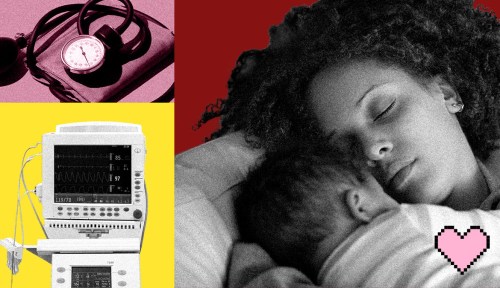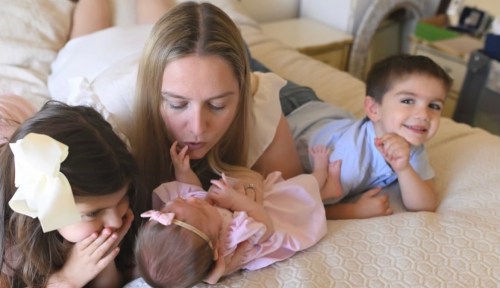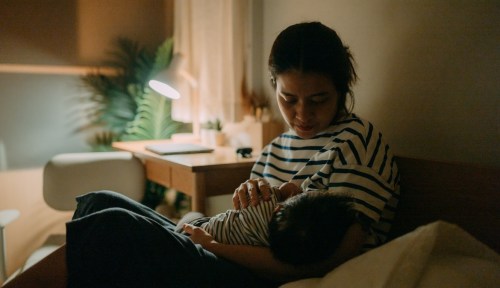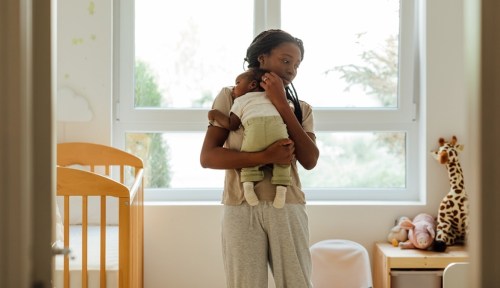The Big ‘Uh Oh:’ My Journey Through Postpartum Preeclampsia
A writer shares her journey with atypical postpartum preeclampsia, including her symptoms, diagnosis, treatment, and long-term effects.

Intuition is a big deal in my house. When my sons were little, we called it the “uh oh” feeling, that indescribable sixth sense that is both intangible and palpable. You know it when you feel it, but it doesn’t have a real beginning or end. You just know you want it to stop.
I’ve lived and learned the consequences of brushing off that feeling. So when my husband and I tell our three sons to never ignore it, it’s a piece of advice I always feel qualified to give.
My biggest “uh oh” to date came at 35 years old. I had been home for just over a week with my youngest son after a grueling C-section followed by a four-day hospital stay. He was perfect. The smoothest brown skin, a swirl of jet-black waves, and the pinkest little lips. Despite my lingering surgical pain, I was spending my first few days home completely blissed out and enchanted by him.
From the moment I found out I was pregnant, I called him our “grand finale.” He was our third boy, youngest by six years, and I knew he was our last. I wanted to soak up every ounce of that delicious new-baby cuteness.
As much as I wanted to get lost in those precious new moments, though, that “uh oh” feeling was taking up all the air. I had an intensifying headache, and my legs and feet were beginning to swell so badly that I couldn’t fit in my socks.
Despite what I subconsciously knew were glaring red flags, I began to make up excuses. I was sure there was a bizarre (but benign) postpartum reason for the swelling, and with two small kids and a new baby at home, I had all the reasons in the world for a headache.
As the day progressed, the headache became so bad my vision started to blur. I finally called my doctor, who urged me to go straight back to labor and delivery.
Less than an hour later, I was lying on a hospital gurney, my cute new baby was being handed to my husband, and there was a bevy of nurses surrounding me, rushing me to intensive care. My blood pressure had skyrocketed to 186/121 (for context, a healthy blood pressure is below 120/80). I was in hypertensive crisis, and my life was at risk.
The rare complication I didn’t see coming
My diagnosis was atypical postpartum preeclampsia, a rare form of preeclampsia (i.e., pregnancy-associated hypertension) that occurs more than 48 hours after giving birth. Preeclampsia’s hallmark symptom is high blood pressure, and other signs can include headaches, swelling, and vision changes, like I experienced, along with shortness of breath, upper-belly pain, nausea, and vomiting.
The condition is most often diagnosed during pregnancy and tends to go away once the baby is born. But it can crop up after birth, too—usually within a few days, but in rarer (read: atypical) cases like mine, up to six weeks postpartum—and this type requires medical intervention to resolve. As an African American woman with a strong family history of hypertension and heart disease, I was at increased risk.
My symptoms were classic, and had I ignored my “uh oh” feeling, I may have suffered a stroke, seizure, or even death.
In the ICU, I was given magnesium sulfate immediately to prevent seizure and emergency blood pressure medications to take down my blood pressure. I was admitted and stayed in the hospital for over a week. Fortunately, my husband and our little “grand finale” were allowed to stay with me so I could continue to nurse.
“I was young. I was otherwise healthy, exercised regularly, and ate well. I desperately wanted my cure to be within my control.”
I wish I could say I handled it with biopic-worthy grace, poise, and strength. The truth is, I was terrified.
I was attached to a blood pressure monitor 24 hours a day. Every 15 minutes it would begin to hum and tighten around my arm, sending readings to on-call doctors and nurses. Sometimes the reading would only be slightly elevated. Other times, it would skyrocket again and nurses would rush in with medications to bring my pressure back down. It could happen while I was nursing, while I was eating breakfast, or even in the middle of the night.
After a few days of nonstop monitoring, the start of the hum began to jump-start my anxiety, as I braced myself for the potential panic a high reading could set in motion. Even worse, the outcome was completely out of my control.
At one point, after a particularly unpredictable day, I ripped off the cuff, hurled it across the room, and threw a full-blown, tear-filled tantrum on my hospital bed. I wanted to go home to my boys, snuggle the new guy on that perfect rocking chair I had picked out while I was pregnant, and never hear the words “blood pressure” again. Fighting for my life in a hospital bed was not part of my birthing plan.
Navigating a new diagnosis—and survivor’s guilt
Ultimately, I maxed out on doses of two medications and was given emergency hypertensive medication twice while I was hospitalized. I was finally released, but with a new diagnosis: chronic hypertension. In other words, my high blood pressure wasn’t in the critical range anymore, but it was sticking around.
I was prescribed 10 pills, divided into three doses a day, with close monitoring from my OB/GYN, primary care doctor, and cardiologist.
I remember lamenting to my then-cardiologist about the amount of medications. I was young. I was otherwise healthy, exercised regularly, and ate well. I desperately wanted my cure to be within my control.
He reminded me that it wasn’t my fault—I wasn’t to blame. Sometimes, he shared candidly, it just happens.
In the months following my hospital stay, I did research on my condition and learned about the countless women—disproportionately women of color—who had lost their lives to preeclampsia. I began to wonder less about how it happened and more about how I survived.
I realized I owed so much of my survival to privilege. I was privileged to have a strong family support system that acted fast to make sure I got to the hospital and that my other children were cared for while I was being treated. I was privileged to have a care team who believed me.
In short, my privilege saved my life. The U.S. maternal death rate is more than 10 times the estimated rate of some other high-income countries. On average, more than 700 women in the United States die of pregnancy-related complications each year. According to the CDC, Black women are more than three times as likely to die of pregnancy-related complications than white women. Upon closer look, 4 out of 5 pregnancy-related deaths have been found to be preventable.
While there are a variety of reasons for these dire statistics, implicit bias, structural racism, and medical gaslighting play an undeniable role in the disparities.
“I realized I owed so much of my survival to privilege. I was privileged to have a strong family support system that acted fast to make sure I got to the hospital and that my other children were cared for while I was being treated. I was privileged to have a care team who believed me.”
After I returned home, I read story after story of Black women who weren’t believed. In 2016, the same year I gave birth to my youngest son, a woman named Kira Johnson gave birth to a beautiful baby boy too. She also had a C-section. However, while she was still in the hospital, her husband, Charles, noticed blood in her catheter. Despite his pleas for help, he was dismissed for nearly 11 hours—one nurse even told him that his wife “wasn’t a priority.” When doctors finally took Kira back to the operating room, she had lost 70 percent of her circulating blood volume. Kira died of an internal hemorrhage.
Reading her story filled me with a sense of survivor’s guilt. If my doctor had told me to stay home that day and try to sleep it off, or had I been turned away when I returned to the hospital because I “wasn’t a priority,” I might have lost my life.
I was lucky. But Kira’s story—and many others like it—show just how far we have to go when it comes to caring for postpartum parents.
Learning to live (and live well) with high blood pressure
Today, my little “grand finale” is a larger-than-life 7-year-old. I am down to five pills a day, and I will likely be on some cocktail of blood pressure medicine for the rest of my life. That isn’t the case for everyone. For some people, their preeclampsia resolves with treatment. But my genes are what likely have set me on a different path.
My maternal and paternal grandmothers died of heart disease, my parents and oldest brother are on blood pressure-managing medications, and one of the best people I’ve ever known, my middle brother, died of congestive heart failure at just 38. We have a strong family history of heart disease, and that put me at an even higher risk of developing preeclampsia.
My high blood pressure is part of my life, and since my diagnosis, I am aware of when I am experiencing symptoms of elevated blood pressure and may need a remix to my medication and/or behaviors. Knowing my risk factors and paying close attention to my stress levels, nutrition, and exercise are key factors that will help me live a long and healthy life.
While it’s not the sexiest thing in the world to pop pills throughout the day (especially the sexiest two I take at bedtime), they are an essential part of how I manage my condition. I have to be mindful of how I eat, how much I move, and how I manage stress. I also have to be vigilant about regular monitoring and surrounding myself with a trusted network of doctors who listen and devise treatment plans that make sense for my body.
I am forever changed by the lessons this experience has taught me—and I was reminded to always trust the “uh oh.”
I believe our bodies tell on themselves. My experience with preeclampsia was a mile marker in my journey that read: Easy now, proceed with care. If you’re fortunate, that is a reminder you only need once.
—medically reviewed by Jennifer Gilbert, MD, MPH
Sign Up for Our Daily Newsletter
Get all the latest in wellness, trends, food, fitness, beauty, and more delivered right to your inbox.
Got it, you've been added to our email list.










